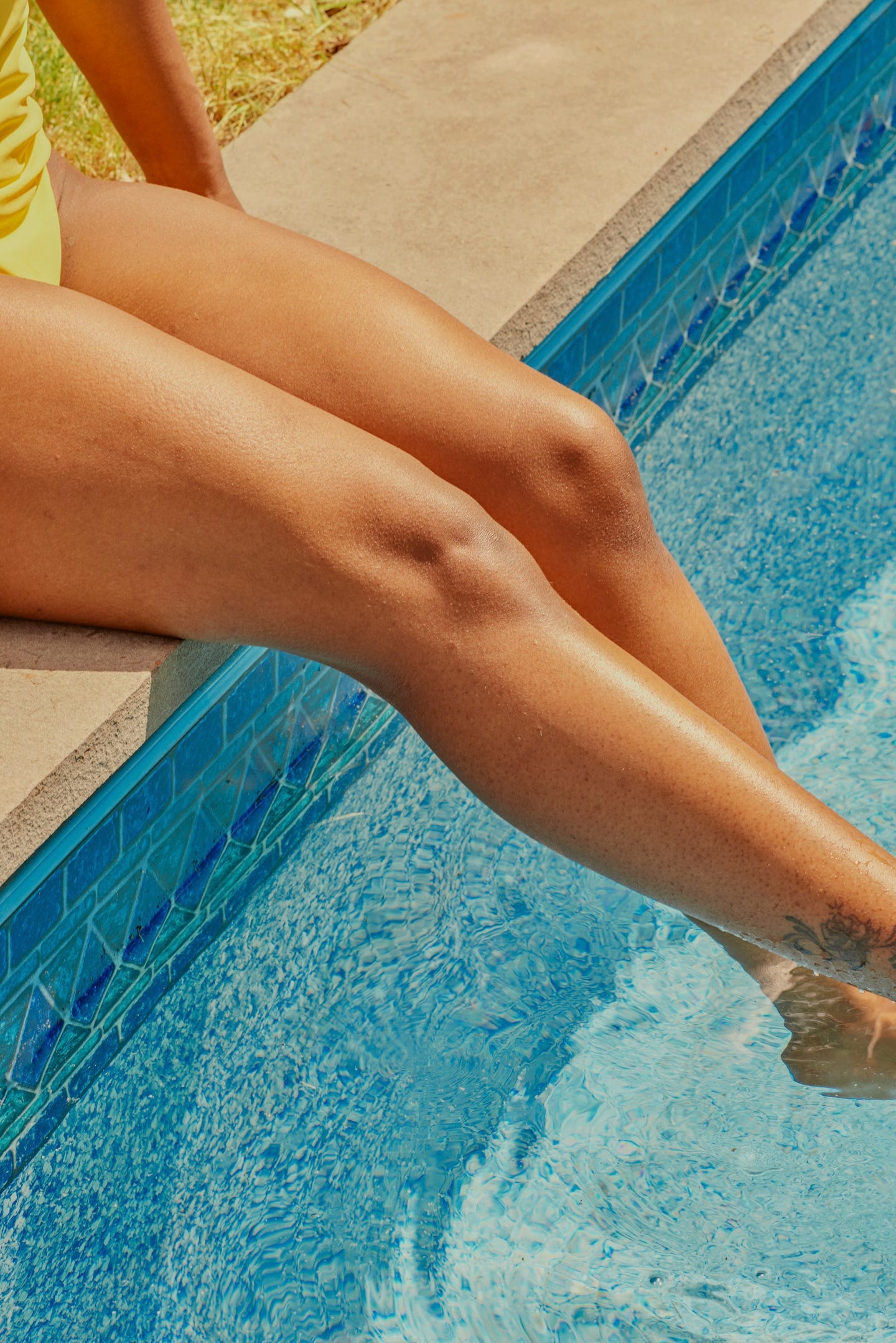
A beginner’s guide to dermaplaning

Dermaplaning is the latest beauty treatment that’s got people talking. A fusion treatment that combines both peach fuzz removal and skincare, the procedure has been featured in top salons everywhere from LA to London. But what is dermaplaning? And why do skincare experts recommend it?
Essentially, a dermaplane facial is an exfoliation and hair removal treatment carried out by a trained beautician during which the surface of the skin is gently scraped using a surgical scalpel to remove dead skin cells and peach fuzz – the small hairs found on the face.
Put like that it sounds kind of scary, but we’re here to smooth things out and answer all your questions.
Veet Sensitive Precision™ Face Kit
Here we answer all your questions about dermaplaning at home. If you’re new to the treatment and want to try it, the Veet Sensitive Precision™ Face Kit is a safe, easy and effective way to doing it yourself.
In-salon versus at home
Until recently, dermaplaning was a treatment that was only available in beauty salons. But now, with our new Sensitive Precision™ Face Kit, all women can experience the benefits of this leading treatment without the expensive salon costs or the hassle of having to book an appointment.
What are the benefits of dermaplaning?
1. Removal of peach fuzz and fine facial hair
Dermaplaning effectively removes fine facial hair and peach fuzz from the forehead, cheeks, chin, and above and below the lips
2. Gentle and effective mechanical exfoliation
Dermaplaning is an exfoliating treatment that removes dead skin cells from the surface of the skin using a gentle blade.
3. Skin that is brighter and healthier looking
Exfoliation removes dead skin cells from the surface of the skin, which can cause the skin to look dull and lacklustre.
4. Smoother skin and an even canvas for make-up
Dermaplaning creates a smooth, more even base, helping foundation to glide on smoothly be applied more evenly.
5. Better absorption of skincare products
After exfoliating, moisturisers and serums can absorb into the skin more easily, boosting the effectiveness of your skincare routine.
Does dermaplaning hurt?
No, if done correctly according to the instructions it does not hurt. Some salon dermaplaning treatments may be harsh but dermaplaning with Veet Sensitive Precision™ Face Kit is a gentle method of facial hair removal. Dermaplaning can sound like an intimidating treatment but don’t worry, we designed the device and safe-guarded the blade for use at home.
Is dermaplaning the same as shaving?
Because dermaplaning uses a blade, it’s similar to shaving but the key differences are that it exfoliates the skin and also lightly scrapes away very fine vellus hair, known as peach fuzz, and dead skin cells. This type of hair doesn’t grow back thick and sharp like other hairs on your body, but just as soft and fine as it was before.
Is it safe to shave peach fuzz on your face?
It is safe to use the Veet Sensitive Precision™ Face Kit. Its unique dermaplaning design means safe, nick-free, peach fuzz removal and facial use’ is best.
Can peach fuzz cause stubble?
No, that’s the beauty of vellus hair. Not only will you achieve smoother, brighter skin with dermaplaning, but the hair will not leave you with stubble.
Will dermaplaning make my facial hair grow back thicker and darker?
No, peach fuzz is very different from terminal hair, which does grow back thicker. Peach fuzz does not.
How often should you dermaplane?
We recommend using the Veet Sensitive Precision™ Face Kit twice a month. You can expect results to last for up to two weeks, although the rate of hair growth will vary from person to person. The treatment should not be carried out more than twice a week or it could irritate and damage the skin.
Can the treatment cause ingrown hairs?
All types of hair removal can cause ingrown hairs. Ingrown hairs happen when the sharp tip of the hair curls back or grows sideways into the skin of the hair follicle, causing red and sometimes itchy bumps. We recommend applying one to two pumps of Veet Miraculous™ Oil to skin that is make-up free and dry before dermaplaning to help prevent ingrown hairs and achieve the most effective results.
What side effects can occur?
Side effects will not occur if you follow the instructions. If you have very sensitive skin, sunburn or a condition such as rosacea or keratosis pilaris, dermaplaning is not suitable as it could irritate your skin. The same goes for inflamed acne – not surprisingly, sliding a blade over spots can irritate them, make them redder and delay healing.
Can you dermaplane if you have breakouts or acne?
If you have inflamed acne or spots which you have picked you should not dermaplane as the treatment can irritate skin and delay the healing process. If you have mild blemishes or blackheads, then dermaplaning is suitable. As long as you avoid any areas of the face where there is irritated or sore skin, moles or cuts, you can dermaplane.
Can you remove peach fuzz if you have sensitive skin?
Dermaplaning is suitable for all skin types, including sensitive skin, but if you have highly reactive skin you may prefer to avoid it. It is not suitable for distressed skin where there is active acne, cuts, moles or open wounds present. The treatment is not suitable for skin affected by psoriasis, rosacea, rashes or sunburn.
Does dermaplaning help reduce blackheads?
Regular exfoliation can help to reduce blocked pores and blemishes when used as part of a good daily skincare routine and healthy lifestyle. Because dermaplaning exfoliates the skin, it clears built-up debris and dead skin cells that can clog up the pores.
Can dermaplaning cause breakouts?
No, dermaplaning does not cause breakouts, it can actually help to prevent them by exfoliating and removing build-up of debris and dead skin skills, which can block pores. However, we recommend using a new, clean blade for each treatment and cleansing the skin before treatments, to prevent the spread of bacteria. Dermaplaning should not be carried out on irritated skin where active acne is present, as this can cause irritation and delay the healing process of spots.
Can I wear make-up after dermaplaning?
Yes! You can apply make-up after dermaplaning but for the best results we recommend that the treatment is carried out in the evening and followed with the application of Veet Miraculous™ Oil or another moisturiser to soothe and nourish skin throughout the night. This will help skincare products get absorbed by the skin.
What should I do after the treatment?
Since your skin barrier will be more vulnerable after dermaplaning, always apply a nourishing and soothing moisturiser afterwards. We have created Veet Miraculous ™ Oil especially for this purpose. Formulated with a blend of 100% natural origin oils, it calms and moisturises the skin for up to 24 hours after hair removal. You should also apply SPF after the treatment before going outside, as any kind of exfoliation makes the skin more sensitive to the sun’s rays.
What is the difference between dermaplaning and microdermabrasion?
While both treatments are designed to rejuvenate the skin and remove dead skin cells, the way that they do this is different. Microdermabrasion exfoliates with fine crystals or a diamond tip that scrapes away the surface layer of dead skin. It can be used to treat scarring, discoloration and stretch marks. The treatment causes minor abrasions and may require up to 10 days of healing time. Dermaplaning is a much gentler procedure, used to remove peach fuzz and provide light exfoliation, which does not require any healing time.
What is the difference between dermaplaning and dermablading?
None at all. They’re just two different names for the same process.


